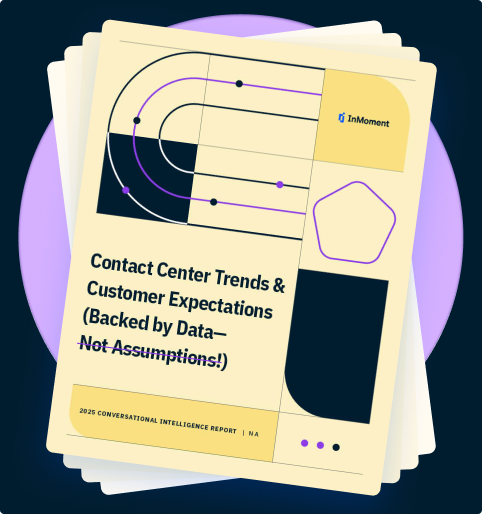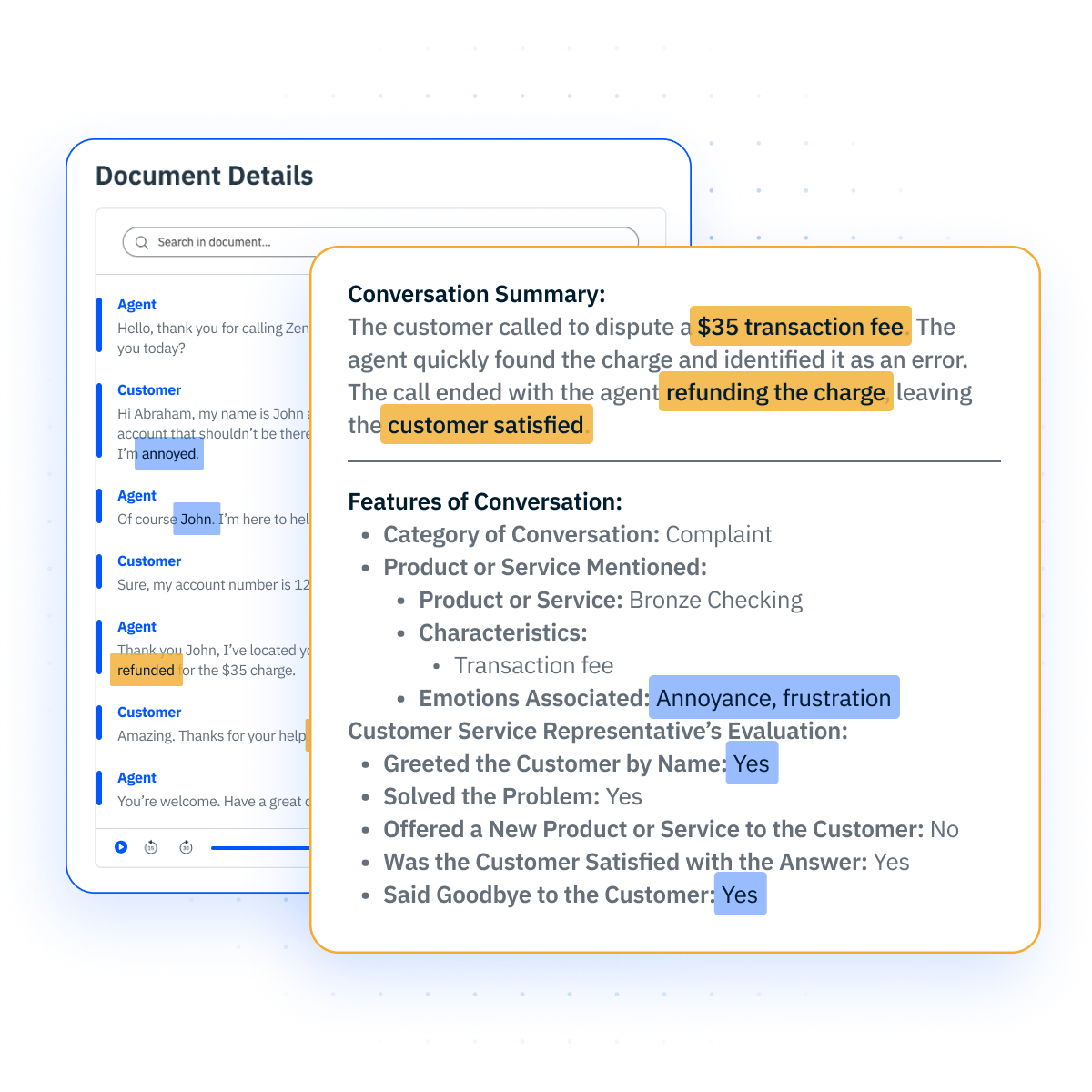The Key Insights Teams Gain From Conversational Intelligence
Discover the key insights teams unlock with conversational intelligence. Learn how CI helps improve customer experience, sales, and marketing strategies.
Competition for customers’ attention is fiercer than ever. A wrong move on your part—be it failing to solve customers’ issues or offering subpar support—could see them looking elsewhere, affecting your retention numbers.
To reduce churn, you need to elevate the customer experience (CX). And we know just the solution to help you: conversational Intelligence (CI).
CI leverages artificial intelligence (AI), machine learning (ML), and natural language processing (NLP) to analyze customers’ interactions with your brand. It provides real-time insights on everything from their pain points to their purchasing triggers, helping you improve experiences and increase sales.
What Are Conversational Intelligence Insights?
Conversational intelligence insights are findings derived from assessing customer conversations with or about your brand.
Conversational analytics software monitors interactions across various touchpoints and channels, including phone call recordings, chatbot transcripts, emails, social media platforms, and business messaging apps, providing a comprehensive view of how customers communicate and what they say about you.
These insights can help you understand customer intent, sentiment, and engagement patterns, improving decision-making, brand-customer communication, and overall customer experiences.
With 37% of consumers leaving brands solely because of poor experiences, the value of these insights can’t be ignored. Think of them as the secret sauce for building customer loyalty.
The Key Insights Gained from Conversational Intelligence
Conversational intelligence is the gift that keeps on giving. It provides a wide range of insights—customer sentiment, pain points, common concerns, market trends, and even agent performance. So you never have to guess what customers want, what drives them to action, or how well your teams meet their needs.
Customer Sentiment and Emotional Tone
With conversational intelligence, you can identify customers who are about to jump ship and focus on retention efforts.
The technology analyzes conversation tones, word choices, and contexts, highlighting the telltale signs of unhappy, dissatisfied, and disengaged customers early on. Based on these findings, you can segment at-risk customers and take proactive steps to minimize the risk of attrition.
Customer Pain Points and Needs
Customers often voice their unmet needs, frustrations, and recurring challenges with customer support and sales teams. CI software detects these concerns in real time, giving you the info you need to refine your brand’s offerings and messaging.
It can show your product development team which features to focus on when creating or updating your offerings, as well as help marketing and sales reps craft messaging that speaks to customers’ frustrations to boost conversion rates.
Buying Intent and Decision Triggers
Conversational intelligence picks up on both apparent and subtle buying signals by analyzing every aspect of your team’s interactions with potential customers.
It can pinpoint direct signals, like customers asking when they can get started with your solution, and the not-so-direct ones, like pricing questions. This can help you qualify leads more effectively, allowing you to focus on high-intent potential customers.
CI technology can also highlight the factors influencing purchase decisions by assessing the kinds of questions customers ask before committing. This can facilitate well-informed development decisions and show you what to highlight in marketing campaigns.
Customer Preferences and Behavioral Patterns
Communication intelligence reveals customers’ preferred communication styles and channels by assessing how they engage with your brand and their most used mediums. This helps you tailor future communications to align with their preferences.
The technology also breaks down customers’ product or service preferences, purchasing behaviors, and decision-making processes, which can facilitate better personalization. For example, it can identify customers who frequently reach out to your sales team to better understand products before committing, so you can be proactive in future interactions.
Objections and Barriers to Conversion
It can be difficult to pinpoint what makes customers hesitate or say no to your offerings, especially if you have many teams working in silos. CI software provides insights by integrating data from sales conversations and inquiries and looking for common concerns among customers who say no.
These insights can help marketing and sales leaders refine their messaging and pitches for better deal closure rates in future interactions. For example, if your tool reports that customers say no because they’re unfamiliar with your brand, teams can incorporate social proof elements, like customer testimonials and case studies, into future pitches to put potential customers’ minds at ease.
Emerging Market Trends and Popular Topics
Conversation intelligence software analyzes large data sets, looking for frequently mentioned keywords and phrases. These terms can provide insight into evolving customer needs and industry trends, allowing you to adjust your strategy accordingly.
If customers ask about sustainability, for example, you can start to budget for eco-friendly initiatives or highlight them in your interactions if you already have some running. Staying ahead of shifting customer needs and expectations helps you stay competitive.
Competitor Mentions and Market Perception
Conversational intelligence analyzes competitor mentions in interactions, showing you who your biggest competitors are and how customers compare your offerings. This information can help you identify areas where competitors are outperforming you and uncover differentiation opportunities.
In other words, if customers mention your brand and competitor brands in price comparison contexts, you’ll know to focus on your affordability (if you’re cheaper) or your product’s value (if you’re more expensive) in future conversations.
Customer Journey Insights and Engagement Patterns
Conversational intelligence tracks customer interactions across different touchpoints, from the point of first contact to post-purchase. By doing so, it can help you identify when customers are the most engaged and where in the sales funnel they drop off—so you know what to improve to boost engagement and conversions.
It can also highlight customers’ questions or concerns at every stage of their purchase journeys, helping you create the right content for each one.
Sales and Upsell Opportunities
CI tools detect signals for cross-selling and upselling by analyzing conversations for high-interest phrases and concerns. For instance, if you’re a SaaS brand with tiered plans, it can look for questions about accessing more advanced features or increasing the number of platform users and recommend upselling opportunities.
These insights can help you capitalize on selling opportunities and maximize your revenue potential. If you offer bundled products, they can also help you better package your offerings to meet customers’ needs.
Agent Performance and Training Needs
Conversational intelligence doesn’t just monitor the customer’s end. It also evaluates how customer-facing teams handle interactions, pinpointing both high-performing agents and areas that need improvement.
These insights can inform agent appreciation initiatives and show you what to focus on in training to improve customer satisfaction and sentiment.
Compliance and Risk Management
CI assesses conversation content and shared information against regulatory requirements, flagging compliance violations that can cause legal risks. This allows you to take appropriate steps to minimize your risk exposure, like engaging legal professionals early.
The AI-driven technology also analyzes interactions against internal company guidelines and highlights violations, letting you know when policy refreshers or updates are needed.
Predictive Analytics and Future Behavior Trends
CI can also help you prepare for future challenges or opportunities by predicting customers’ actions based on historical conversation data.
Say your data shows that customers frequently talk about competitors before they abandon ship. It can look for this red flag in current interactions, letting you know when there’s a high churn risk so you can take proactive retention strategies.
Similarly, if it determines that potential customers start engaging more frequently just before they’re about to convert, it can look for this signal in current conversations, helping you prepare for increased product or service demand.
How Different Teams Can Use CI Insights to Their Advantage
Conversational intelligence insights take the guesswork out of many teams’ interactions with customers, empowering them with the information they need to promote positive outcomes. Here’s a quick look at the teams that benefit most and how they can leverage these insights effectively.
Customer Support and Success Teams
CI insights help customer support and success teams protect account health by identifying frustrated and dissatisfied customers. They can then prioritize them for immediate follow-ups and support, potentially reducing churn.
These insights also highlight recurring concerns, trends, and team performance, which can inform response quality improvement and skill development efforts.
Example: Contact center agents in the telecom industry use CI to identify customers at risk of churning based on sentiment and engagement patterns, passing them over to retention to proactively address their issues and find a resolution.
Marketing Teams
With most companies cutting marketing budgets first in periods of market uncertainty, marketing teams can’t afford to make unfounded guesses when running campaigns.
CI insights promote well-informed marketing campaigns by helping teams refine their ideal customer profiles (ICP). They highlight both demographic and firmographic data, as well as areas like pain points and decision triggers—all vital for ICP development. Well-defined ICPs minimize the risk of wasting resources on target markets that are unlikely to convert.
Further, these insights also reveal customer communication preferences and motivations, which can help teams refine messaging and campaign strategies to resonate better with their target audiences. They also pinpoint high-intent customers and help teams identify them within each geographic area, allowing for well-informed location-based campaigns.
Example: A B2B marketing team’s CI software detects that customers frequently ask about product integration capabilities. To encourage conversions, the team highlights its solution’s capabilities and mentions the kinds of tools it integrates with in marketing campaigns.
Sales Teams
The days of pitching to every potential customer and hoping they’ll convert are over—thanks to CI technology. It differentiates hot and cold leads by looking for buying signals like “we’re in the market for something like X,” allowing sales teams to prioritize high-intent segments.
CI insights also highlight customer pain points and the reasons for hesitation or objections in the sales process, helping teams develop more effective pitches and overall sales strategies.
Example: A health and wellness sales team uses CI to analyze its interactions with customers and finds that they hesitate to book services because they aren’t sure what’s included. Based on this insight, the team revises its sales pitch to clearly lay out what’s offered in each package and what customers can expect if they sign up.
Customer Insights Teams
Manually combing through mountains of data to understand customer behavior, needs, and preferences can feel like punishment, even for the hardest-working employees. Plus, the process takes a lot of time, which doesn’t cut it in the world of constantly evolving customer needs.
Luckily, customer insights teams can always use CI. It analyzes large datasets to identify themes, patterns, pain points, and trends that could improve customer understanding.
Take Discover, one of Pearl-Plaza’s latest products. It analyzes billions of data points to identify CX insights and sends you notifications in real time, keeping you informed on dynamic customer needs and industry trends.
Example: Thanks to CI, a customer insights team in the automotive industry determines that sustainability is becoming a growing concern for current customers. Therefore, it recommends that the brand consider adding new models and trim packages to its limited line of electric vehicles.
Product Teams
CI insights help product teams prioritize feature developments based on direct customer feedback and real-world demand, aligning products with user needs.
These insights also highlight usability issues that impact the customer experience and product gaps (based on comparisons with competitors), helping product teams focus on developments that positively impact customer retention and brand positioning.
Example: A software development product team finds that customers frequently struggle to navigate their solution’s interface. To reduce the risk of churn, it prioritizes improving its product’s ease of use over adding new features.
Ecommerce
CI helps ecommerce teams improve customer service and personalize shopping experiences by analyzing customer interactions related to product inquiries, shipping concerns, and purchase behavior. By addressing deficiencies in these areas, teams can improve conversion rates and minimize cart abandonment.
Example: CI insights help an ecommerce brand segment customers by the products they show the most interest in, facilitating personalized messaging and offers.
How To Implement Conversational Intelligence for Actionable Insights
Implementing conversational intelligence into customer interactions is relatively straightforward. Use this step-by-step guide to start leveraging CI for actionable insights in your business.
Step 1: Choose the Right CI Tool
The first step is to choose a reliable conversation intelligence tool that aligns with your needs. Your top priority should be finding one that goes beyond transcribing interactions, providing actionable insights into things like customer engagement levels and pain points.
That said, transcription capabilities are still pretty great, as they convert audio recordings to text for easier analysis. Other factors to consider include:
- Sentiment analysis: Your tool should be able to gauge whether customers’ feelings toward your brand are positive, neutral, or negative based on their tone and word choice.
- Summarization: This feature eliminates the need to sift through heaps of customer conversations to gather hidden gems.
- Agent performance metrics: Scorecards can help you identify both high-performing agents and areas for improvement.
- Categorization capabilities: The ability to classify customer conversations by sentiment, buying intent, or specific keywords can streamline analyses.
Beyond these factors, you also need to assess a conversation intelligence platform’s ease of use, scalability, security, and integration capabilities before committing to make sure it’s the right fit.
Step 2: Integrate CI with your Existing CRM, Marketing, and Analytics Platforms
After finding the right tool, integrate it with your current customer interaction systems, including:
- Customer relationship management (CRM) tools like Salesforce and HubSpot
- Data management solutions like Zapier and Oracle
- Communication platforms like Slack and Gmail
- Review platforms like Outreach and Google Reviews
- Analytics platforms like Google Analytics
Integrating CI with existing systems promotes a smooth flow of conversation data, making it easier for teams to track insights across customer interactions and marketing campaigns.
Step 3: Define the Metrics and KPIs your Team Will Track With CI Insights
While less overwhelming than actual conversation data, CI insights can seem like a lot if you don’t know what to focus on. So set clear objectives and define key metrics and KPIs upfront.
Depending on your objectives, you might track metrics like call resolution rates, engagement scores, lead conversion rates, and customer sentiment scores. If your main reason for investing in CI software is to improve agent performance, for example, call resolution rate would be an excellent metric to monitor.
Step 4: Use CI Data to Iterate and Refine Strategies Continuously
The final step is to use your CI insights to refine communication tactics, customer support processes, and decision-making across sales, marketing, and product development teams. Focus on the most pertinent or pressing action items first to get a lot of value upfront, then you can start tackling the smaller or less impactful items on your list.
However, this shouldn’t be a one-time process. Continually leverage CI data to identify patterns, trends, and shifts in customer needs over time, and adjust your approaches to optimize business strategies as markets change.
Unlock Powerful Conversational Insights With Pearl-Plaza
Conversational intelligence unlocks a world of valuable data across many business departments—sales, marketing, customer support, product development, ecommerce, and customer insights.
Whether you want to help your sales team elevate their pitches, get your development team to work on what customers actually want, or reduce cart abandonment rates by catering to customers’ unique needs, this technology has you covered.
With Pearl-Plaza’s conversational intelligence technology, you’ll get insights into everything from customer sentiment to industry trends, facilitating smarter decision-making. Our integrated CX platform monitors and analyzes customer interactions across every medium, ensuring you never miss a beat.
Learn how Pearl-Plaza’s CI and analytics technology and centralized CX platform can fuel data-driven improvements throughout your business!





